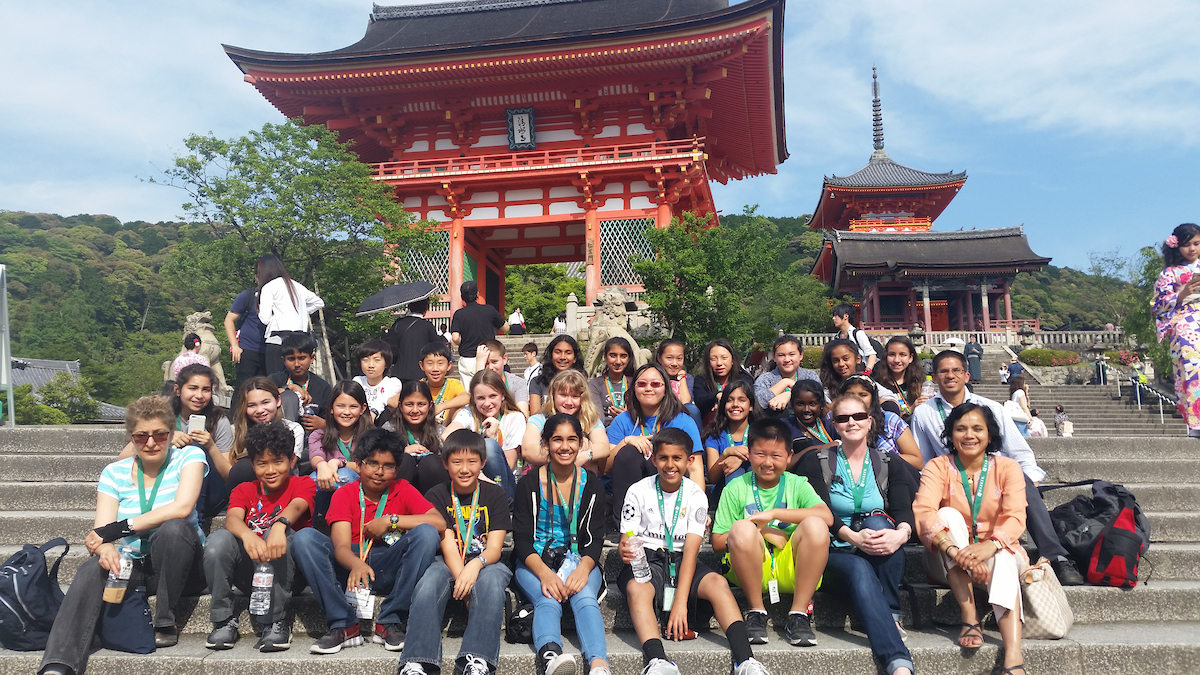In mid-May, a group of Harker sixth graders traveled to Japan for the yearly visit to Tamagawa Academy. In addition to visiting their buddies, the trip gave students the opportunity to see many of Japan’s most famous landmarks and learn about the country’s rich culture.
The group’s first full day in Tokyo started with a visit to the Suginami Animation Museum, where students attended an animation workshop. “A set of eight pictures is scanned to make a one-second animation,” reported Vandana Kadam, grade 6-8 math department chair and one of the chaperones on the trip. “Students had a lot of fun doing it.” Later, the group headed to the Edo-Tokyo Museum to view its rich collection of art and cultural artifacts from Japan’s Edo period (1603-1867). Other highlights included seeing the 18-meter tall statue of Gundam, the titular robot of one of Japan’s most popular animated series, and getting a spectacular view of the Rainbow Bridge as the sun went down.
Saturday’s big event was the visit to Tamagawa Academy, where students met up with their buddies. “The drive to Tamagawa was used to practice their Japanese speeches, and as the coach rolled into the campus, a huge surprise awaited the students,” said Kadam. “The host families with buddies and siblings were waiting for our students with beautiful signs, flowers and other things that would make our students feel very welcome.” At an assembly, the Tamagawa students introduced themselves, and Toshiyuki Ibe, headmaster of Tamagawa’s lower secondary division, gave a special address. Following a video message from Harker Head of School Chris Nikoloff, the Harker students and faculty introduced themselves in Japanese. The students then departed to be with their homestays for the weekend.
On Monday, the students returned to Tamagawa for their first day of classes. The Harker students regaled their chaperones with stories of sightseeing in and around Tokyo, including Tokyo Tower, Tokyo Disneyland, Edo Wonderland, Mt. Fuji and more. Everyone received a warm welcome from Tamagawa’s students, who sang at a morning assembly. Afterward they learned about the history of Tamagawa from its president, Yoshiaki Obara, who also informed the students about Japanese culture and religious customs.
The ensuing two days were a whirlwind of activity for the Harker students and chaperones. They learned how to write their names in Japanese, made candles from beeswax and tasted honey straight from the honeycomb at a honey bee farm, and visited Tamagawa’s famous planetarium. “They watched an interactive show as the narrator was talking about the position of Tokyo and San Jose and how the skies would look similar due to the fact that the two cities have almost the same latitudes,” Kadam said.
On their final day with their Tamagawa buddies, the Harker students observed some elementary school classes and attended a potluck lunch hosted by Tamagawa parents. At a special farewell assembly, the Harker students enjoyed an entertaining magic show by Tamgawa students, and gathered to sing “The Harker School Song.” After exchanging tearful goodbyes, Harker’s students set off for Kyoto.
Japan’s former imperial capital offered a wealth of sights to see, including the famous Golden Pavilion with its brilliant gold-leaf coating. Students visited the centuries-old Nijo Castle, built by military leader Tokugawa Ieyasu, the head of the Tokugawa Shogunate. “The wooden floors here squeak so that the Shoguns [military dictators] could detect any intruders to the castle,” Kadam said. “These floors are called nightingale floors.” At the castle, the students learned about the Shogun’s meetings with feudal lords and advisers, and saw his private quarters. At Kiyomizu Temple, the students drank from the stream flowing from the nearby mountains, which is said to bring good fortune and health.
Early the next morning, the students were briefed on the purpose of visiting their next destination, and boarded a bullet train bound for Hiroshima. “They were extremely well behaved and were very sensitive to the history of Hiroshima,” Kadam said. Students were made aware of the destruction caused by the atomic bombing.” Their first stop was the Hiroshima Peace Memorial, also known as the A-Bomb Dome, a ruin that remains standing as a memorial to the victims of the 1945 Hiroshima bombing. They later headed to the Children’s Peace Monument, where they left 1,000 paper cranes they had folded, before visiting the Peace Memorial Museum.
After their activities in Hiroshima, the group boarded a ferry to Miyajima Island. They toured the Itsukushima Shrine and viewed its famous Tori gate, which is partially submerged in water.
The students’ final day in Japan was spent at a snow monkey habitat. “There is an enclosed area for people to buy food and offer it to monkeys that are outside of the enclosure. It is just fascinating to see how nicely the monkeys take the food from your hand and put it in their mouth,” Kadam reported. “Needless to say that this was, for the students, the highlight of the last few days of the Japan trip.”
